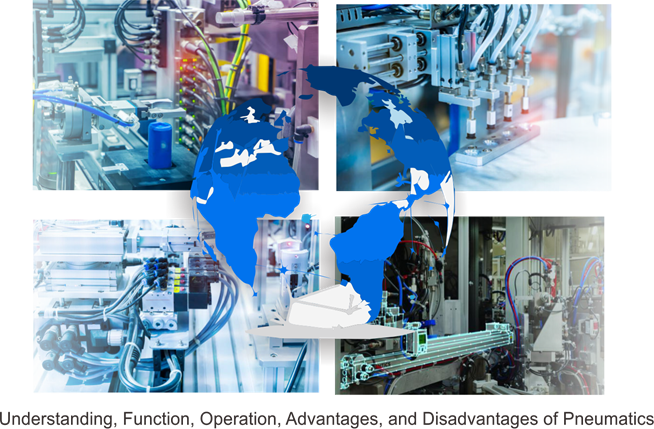Understanding, Function, Operation, Advantages, and Disadvantages of Pneumatics
Pneumatics is the science that studies the movement or displacement of air, as well as the phenomena related to air. In other words, pneumatic refers to the study of the movement of air that can be utilized to generate power and speed (Akhmad, 2009). Personally, I believe that Pneumatics is a system of propulsion that utilizes air pressure as its driving force. The air pressure is obtained from a compressor, and once the air is collected in the compressor, it is then directed into the pneumatic system. Before the air is directed into the pneumatic system, it is first filtered to secure the system and its components from contaminated air or water produced by the compressor.
A. The Function of Pneumatics
For everyday life applications, pneumatics is generally used easier human work. An example of its application is in braking systems for large vehicles such as trucks, which utilize pneumatic (air pressure) braking systems. The brakes used in commercial trucks employ a pneumatic system assisted by hydraulic pressure to enhance braking efficiency and saft B. Advantages and Disadvantages of Pneumatics
Advantages of Pneumatic Systems:
- Cost-effective: Components are affordable and readily available.
- Space-efficient: Pneumatic components require minimal space compared to hydraulic components due to their small and lightweight nature.
- Safety: Less prone to explosions and fires as they utilize air as their power source, reducing the risk of combustion.
- Fire-resistant: The power source being compressed air eliminates the risk of fire within the machine.
- Robust construction: Pneumatic components are designed to withstand specific pressures, ensuring durability.
- Clean and dry: Malfunctioning components do not result in a messy workspace due to the use of compressed air, keeping the environment dry.
- Easy to clean: Components can be cleaned without the need for washing, simply using a clean cloth.
- Accessible power source: Compressed air, the power source, is readily available, making it easily accessible.
- Environmentally friendly: Pneumatic components are lighter and space-efficient, making them more eco-friendly compared to hydraulic counterparts.
Disadvantages of Pneumatic Systems:
- Low mechanical power output: Pneumatics are suitable for machines that do not require high pressure, such as press machines.
- Noisy components due to exhaust paths: Without proper exhaust paths, actuators cannot return to their initial positions.
- Formation of ice: Prolonged presence of water vapor pressure can lead to the formation of ice on components, potentially causing damage.
- High energy consumption: Operating costs for pneumatics can be significant due to the use of compressors as a power source. Continuous compressor usage in pneumatic-dependent industrial facilities can lead to increased electricity expenses.
From the image below an application of a pneumatic circuit. In this simple circuit, there is a double-acting cylinder, a 3/2-way valve actuated by a spring-return push button, and an ASU (Air Service Unit). The ASU serves to filter the air supplied by the compressor, as air from the compressor often contains water vapor and sometimes oil. The control system utilizes a 3/2-way valve actuated by a spring-return push button, while the actuator employs a single-acting cylinder with a return spring.



%20_%20SiddixHub.png)
Komentar
Posting Komentar